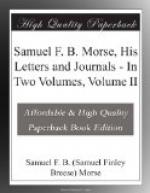“In this country, young in the arts, there are few means of improvement. These are to be found in their perfection only in older countries, and in none, perhaps, greater than in yours. In compliance, therefore, with his earnest wishes and those of his friend and patron, Mr. Allston (with whom he goes to London), we have consented to make the sacrifice of feeling (not a small one), and a pecuniary exertion to the utmost of our ability, for the purpose of placing him under the best advantage of becoming eminent in his profession, in hope that he will consecrate his acquisitions to the glory of God and the best good of his fellow men.”
Morse arrived in New York on July 6, 1811, after a several days’ journey from Charlestown which he describes as very terrible on account of the heat and dust. People were dying from the heat in New York where the thermometer reached 98 deg. in the shade. He says:—
“My ride to New Haven was beyond everything disagreeable; the sun beating down upon the stage (the sides of which we were obliged to shut up on account of the sun) which was like an oven, and the wind, instead of being in our faces as papa supposed, was at our back and brought into our faces such columns of dust as to hinder us from seeing the other side of the stage.
“I never was so completely covered with dust in my life before. Mama, perhaps, will think that I experienced some inconvenience from such a fatiguing journey, but I never felt better in my life than now.”
The optimism of youth when it is doing what it wants to do.
He had taken passage on the good ship Lydia with Mr. and Mrs. Allston and some eleven other passengers, and the sailing of the ship was delayed for several days on account of contrary winds, but at last, on July 13, the voyage was begun.
ON BOARD THE LYDIA,
OFF SANDY HOOK, July 15, 1811.
MY DEAR PARENTS,—After waiting a great length of time I have got under way. We left New York Harbor on Saturday, 13th, about twelve o’clock and went as far as the quarantine ground on Staten Island, where, on account of the wind, we waited over Sunday.
We are now under sail with the pilot on board. We have a fair wind from S.S.W. and shall soon be out of sight of land. We have fourteen very agreeable passengers, an experienced and remarkably pleasant captain, and a strong, large, fast-sailing ship. We expect from twenty-five to thirty days’ passage.... We have a piano-forte on board and two gentlemen who play elegantly, so we shall have fine times. I am in good spirits, though I feel rather singularly to see my native shores disappearing so fast and for so long a time.
I am not yet seasick, but expect to be a little so in a few days. We shall probably be boarded by a British vessel of war soon; there are a number off the coast, but they treat American vessels very civilly.
He kept a careful diary of the voyage to England and again resumed it when he returned to America in 1815. The voyage out was most propitious and lasted but twenty-two days in all: a very short one for that time. As the diary contains nothing of importance relating to the eastern voyage, being simply a record of good weather, fair winds, and pleasant companions, I shall not quote from it at present.




